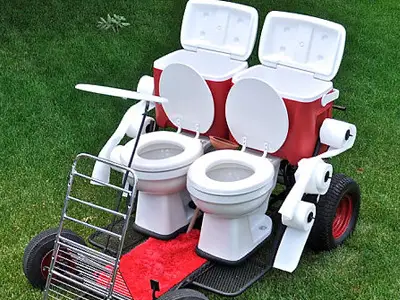Did you ever think of why anyone would need a potty golf cart? I’ll bet the inventor thought there was a market need for it, am I right?
I’m remembering a young interior designer client I had at the start of my business. Her name was Jodie. She had come up with the idea of a warehousing software. She then dumped all her life savings into the development of this software. When she found it hard to sell, she hired me to help her. When we did the market research around who this could help and what pain it helped solve, we were stumped. Nobody was buying because there was no perceived market need. This poor woman, who had a special needs child and was a single woman was doomed. I felt my heart break for her.
She is not alone, according to research, the number one reason why businesses fail is because there’s no market need for their product or service. What about for established businesses?
We’ve Got One Already, Thanks
Sara owned an IT company and she was losing one of her biggest clients to a competitor. In a panic, she hired me to help her attract new corporate clients. It turned out that the one common thing she kept hearing from prospects was “we’ve already got an IT company that we work with, no thank you.” Now, you might be asking yourself how Jodie and Sara’s problems are related? They both need to research the market. Let me explain.
Find The Gap In The Market
Research is the only way to find the gap so they can position into it. In Jodie’s case, to launch a new product and Sara’s case, to hook a buyer’s interest in one small area of their need to get a meeting. After all, CB Insights data reveals that 42% of businesses fail because of lack of market need. On the other hand, we already know that 86% of buyers don’t see the difference between two vendors. The antidote to both problems is to find out what is the most relevant and expensive problem an industry that you can target has.
The Process
The steps to find the gap in the market are simple. The first step is to divide the market into homogenous buckets. Luckily humans already do that for you by self-congregating in large numbers by industry or interest. So pick a few of these and then hypothesize about their most expensive problems that you can solve with your products and services. Next, validate the biggest pain point and lastly position your messaging around the winning pain point. Voila, you have your unique positioning into the gap in the market.
Hindsight is 20-20
If Jodie had gone through this process before making her product, she could have found out before spending a dime on development that nobody would pay for this thing. When Sara went through this process, she found that there was a huge problem in the healthcare industry that she could help by reducing call wait times at call centres. Then she proceeded to sell almost a Million Dollars of that service within a few months. As they say, hindsight is 20-20.
So if you want to avoid falling into the number one business trap, keep a steady finger on the pulse of the market you play in. Do it strategically and do it systematically without emotion or guesswork. Numbers and prospects never lie.
Want to reposition your messaging to grow your leads? Follow me on Twitter, friend me on Facebook, watch my Podcast on YouTube or connect with me on LinkedIn –and let’s talk.





0 Comments